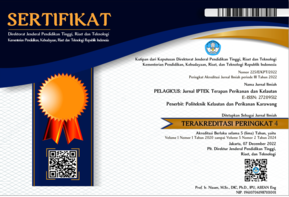Suitability of Selat Nasik Water Conditions for Tiger Grouper Cultivation in Floating Net Cage Systems
Abstract
According to the suitability of water conditions for tiger grouper aquaculture, there are several water quality factors such as temperature, pH, salinity, water depth, current speed, water brightness, and dissolved oxygen. The purpose of this study was to analyze the value of the physical-chemical parameters of the waters and the suitability of the water conditions for the cultivation of tiger grouper (Epinephelus fuscoguttatus) in the Nasik Strait waters. This research was conducted in February 2021 with water quality analysis carried out in situ and ex-situ (Environmental Services Laboratory) at 4 different stations. The method used in this research is descriptive qualitative and the purposive sampling method is used to determine the location of the station. Observation of water conditions using physical and chemical parameters consisting of temperature, pH, salinity, water depth, current speed, water brightness, and dissolved oxygen and carried out using matching methods for data analysis. The results of this study indicate that the waters of the Nasik Strait have a sufficient level of suitability for tiger grouper aquaculture according to the results, namely; Station 1 with a suitability value of 87%, which is put in the Very Suitable class (1), Station 2 with a suitability value of 87%, which is put in the Very Suitable class (1), Station 3 with a suitability value of 80% which is put in the class Sufficiently Appropriate (S2), and at Station 4 having a suitability value of 80% is put in the Sufficiently Appropriate (S2) class. The results show that the waters of the Nasik Strait are in the category of Very Suitable and Fairly Suitable for the development of tiger grouper aquaculture and indicate that the waters of the Nasik Strait are suitable as cultivation locations and need to be maintained regarding water quality by managing water quality management.
Keywords
Full Text:
PDFReferences
BBPBL. (2001). Modul Teknologi Reproduksi Ikan Kerapu Macan (Epinephelus fuscoguttatus),. Riset dan Teknologi Balai Besar Pengembangan Budidaya Laut Lampung.
Cornelia, M. (2005). Modul Prosedur dan Spesifikasi Teknis Analisis Kesesuaian Budidaya Rumput Laut. Pusat Survey Sumberdaya Alam Laut.
Ghufran, M. H. (2010). Pemeliharaan Ikan Kerapu Macan (Epinephelus fuscogutattus) di Keramba Jaring Apung. Akademia.
Kordi, K. G., & Tancung, A. B. (2010). Pengelolaan Kualitas Air dalam Budidaya Perairan. Rineka Cipta.
Meiyana, E. M., & Aditya., T. W. (2001). Modul Pembesaran Kerapu Macan (Epinephelus fuscogutattus) Dan Kerapu Tikus (Epinephelus altivelis) di Keramba Jaring Apung.
Radiarta, N., Wardoyo, S.E., Priono, B., & Praseno, O. (2007). Aplikasi Sistem Informasi Geografis untuk Penentuan Lokasi Pengembangan Budidaya Laut di Teluk Ekas, Nusa Tenggara Barat. Jurnal Penelitian Perikanan Indonesia 9: 67-79.
Romimohtarto, K., & Juwana, S. (1999). Biologi Laut: Ilmu Pengetahuan tentang Biota Laut. Pusat Penelitian dan Pengembangan Oseanologi. LIPI.
Setianto. D. (2015). Usaha Budidaya Ikan Kerapu. Pustaka Baru Press.
Sudradjat. A. (2008). Budidaya 23 Komoditas Laut Menguntungkan. Penebar Swadaya.
Valentino, G., A.D, A., & Yulianto, H. (2018). Analisisi Kesesuaian Perairan Untuk Budidaya Ikan Kerapu Macan (Epinephelus fuscogutattus) Di Perairan Pulau Tegal Kecamatan Teluk Pandan Kabupaten Pesawaran. Jurnal Rekayasa Dan Teknologi Budidaya Perairan., Vol. IV No.2.
DOI: http://dx.doi.org/10.15578/plgc.v3i3.11815
Refbacks
- There are currently no refbacks.

This work is licensed under a Creative Commons Attribution-ShareAlike 4.0 International License.
E-ISSN: 2720-9512
ISSN: 2715-9620












